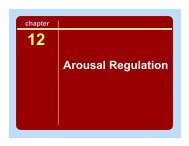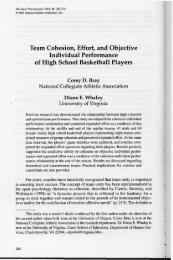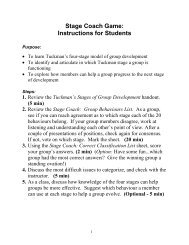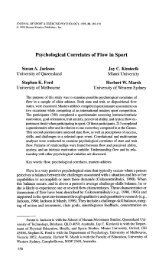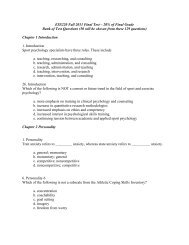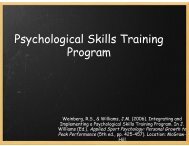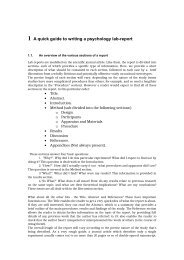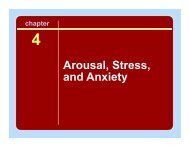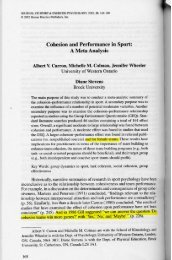Sport and Exercise Psychology Review - Sport Psychology Goes to ...
Sport and Exercise Psychology Review - Sport Psychology Goes to ...
Sport and Exercise Psychology Review - Sport Psychology Goes to ...
Create successful ePaper yourself
Turn your PDF publications into a flip-book with our unique Google optimized e-Paper software.
Book <strong>Review</strong><br />
chapters in this section gel <strong>to</strong>gether well. In<br />
Chapter 1, Aidman <strong>and</strong> Scofield bring new<br />
reflections <strong>and</strong> approaches <strong>to</strong> Morris’s<br />
original chapter on traditional approaches<br />
of assessment by drawing upon themes of<br />
athletic identity <strong>and</strong> self-concept <strong>to</strong> offer<br />
wider considerations in an area hindered by<br />
issues of measurement. Chapter 2 is a new<br />
<strong>to</strong>pic addition by Terry on mood <strong>and</strong><br />
emotion, which efficiently assesses current<br />
models in the literature <strong>and</strong> greatly supports<br />
reader accessibility by presenting relevant<br />
empirical findings alongside theory. In<br />
chapter 3, the scope within the area of<br />
anxiety is given full recognition. Hale (1997)<br />
criticised the first edition suggesting the<br />
<strong>to</strong>pic would be more appropriately<br />
addressed if the consideration of applied<br />
interventions for anxiety was carried in<br />
another part of the text. The edi<strong>to</strong>rs appear<br />
<strong>to</strong> have tidied up this area which literally<br />
sprawled across four chapters over two parts<br />
of the book, by dividing the matter in<strong>to</strong> two<br />
succinct <strong>and</strong> fittingly located chapters, one<br />
theory based <strong>and</strong> the other applied. As such,<br />
Marchant <strong>and</strong> Morris present a full review of<br />
key developments in sport anxiety research<br />
including reversal theory <strong>and</strong> an<br />
examination of the antecedents of choking.<br />
This chapter is notable for a particularly<br />
international selection of real world<br />
examples <strong>and</strong> discussion, which ably sets the<br />
scene for consideration of applied<br />
perspectives in a chapter in the subsequent<br />
part of the book. In Chapter 4, Moran <strong>and</strong><br />
Summers thoroughly cover the three key<br />
theoretical perspectives in a well-organised<br />
chapter that also examines the dimensions<br />
of attention. Previously manifesting as a<br />
single chapter on individual <strong>and</strong> social<br />
motivation, Chapters 5 <strong>and</strong> 6 (on intrinsic<br />
<strong>and</strong> extrinsic motivation by Frederick-<br />
Recascino <strong>and</strong> Morris <strong>and</strong> achievement goal<br />
theory by Chi, respectively) share the<br />
motivational load in a development that<br />
better acknowledges the diversity of theory<br />
in this area <strong>and</strong> permits more thorough<br />
examination of these facets. This potentially<br />
allows readers <strong>to</strong> more accurately target<br />
particulars fields.<br />
In this second edition, prior chapters on<br />
attribution theory <strong>and</strong> social facilitation have<br />
been removed. Additionally, Morris’s original<br />
chapter on self-efficacy is now consumed<br />
within Chapter 7, which focuses on Selfconfidence<br />
<strong>and</strong> is authored by Morris <strong>and</strong><br />
Koehn. An excellent reflection on the dual<br />
concepts of state self-confidence <strong>and</strong> sport<br />
confidence alongside self-efficacy is coupled<br />
with a critique of currently utilised<br />
inven<strong>to</strong>ries in this chapter. However, it is<br />
somewhat let-down by a future directions<br />
section that fails <strong>to</strong> present any firm potential<br />
developments in a relatively under<br />
researched area of sport psychology. Closing<br />
with Chapter 8, Hodge presents current<br />
perspectives in team dynamics in a<br />
comprehensive review coloured with solid<br />
up-<strong>to</strong>-date practical examples, it is especially<br />
accessible. As a whole, the revised Part 1 feels<br />
far more substantial <strong>and</strong> it is undoubtedly<br />
more functional as the parts of its sum appear<br />
<strong>to</strong> be pulling their individual weight.<br />
In an especially damning part of his review<br />
Hale (1997) concluded that part 2 of the<br />
original text did not succeed as an updated<br />
analysis due <strong>to</strong> lack of research grounding<br />
<strong>and</strong> how-<strong>to</strong> intervention explanations <strong>and</strong><br />
cited several chapters as ‘weak’. Whilst no<br />
chapters in the section have been replaced as<br />
such, renowned contribu<strong>to</strong>rs have again been<br />
sought <strong>to</strong> provide fresh approaches <strong>to</strong> current<br />
key issues. This is apparent in the new<br />
Chapter 10 on Goal Setting, now contributed<br />
by Weinberg. Not only is content overhauled,<br />
but also the way the information is structured,<br />
or proffered, for use. This chapter in the<br />
original edition largely consisted of on a brief<br />
goal setting cookbook. In this second edition,<br />
Weinberg provides a very accessible review of<br />
the industry vs. sport <strong>and</strong> exercise setting<br />
research debate. Additionally, the weaker<br />
links in the chain of the goal setting process<br />
are identified through examination of recent<br />
research in<strong>to</strong> elite athletes <strong>and</strong> coaches<br />
attitudes <strong>to</strong> <strong>and</strong> usage of goal setting. This<br />
serves <strong>to</strong> put forward a far more rounded<br />
presentation of an area frequently sought-out<br />
54 <strong>Sport</strong> & <strong>Exercise</strong> <strong>Psychology</strong> <strong>Review</strong> Vol 1 No 2



